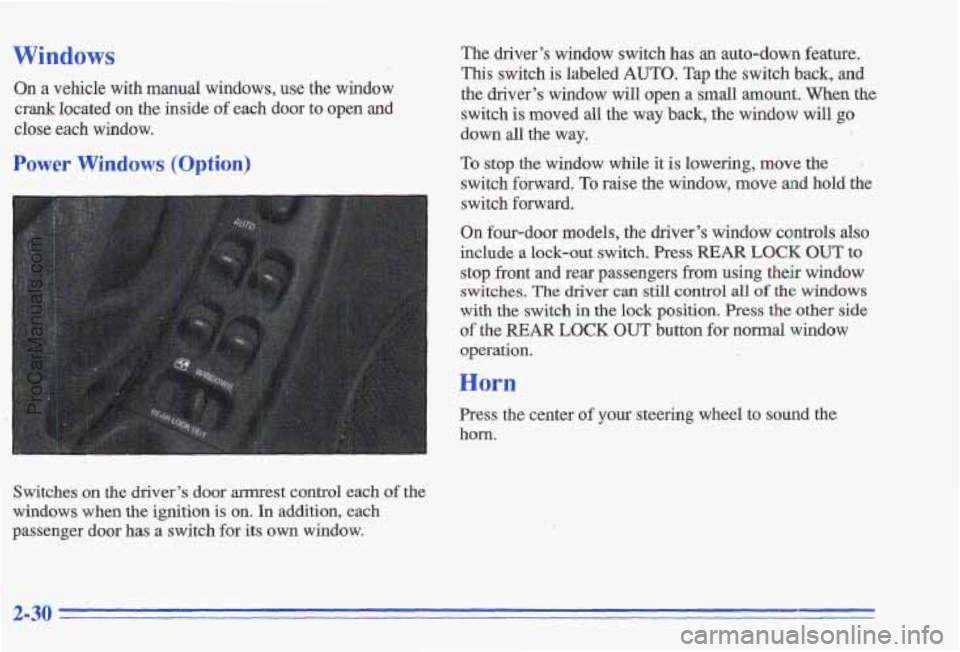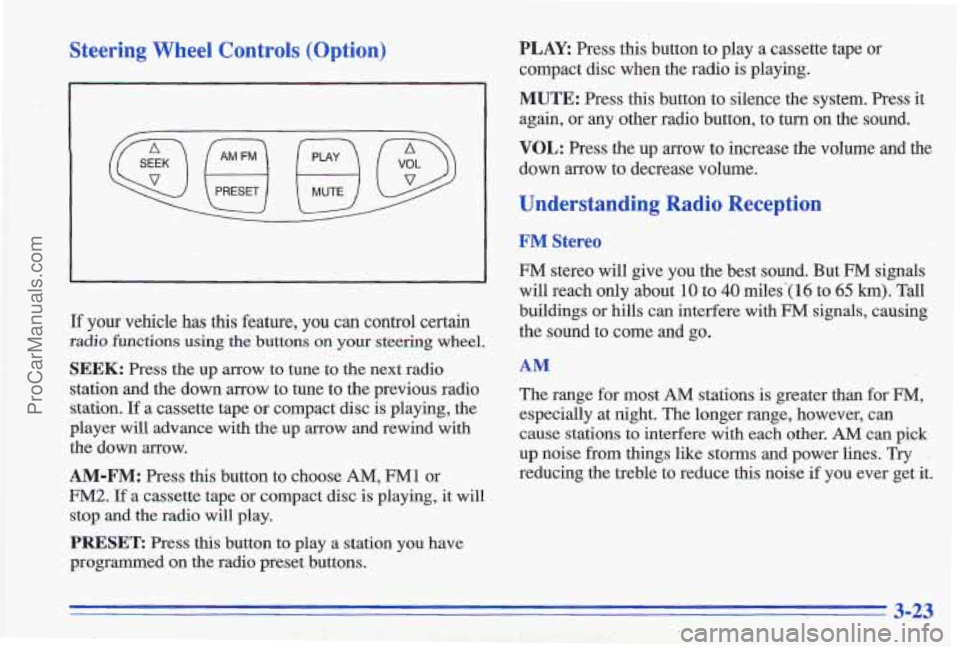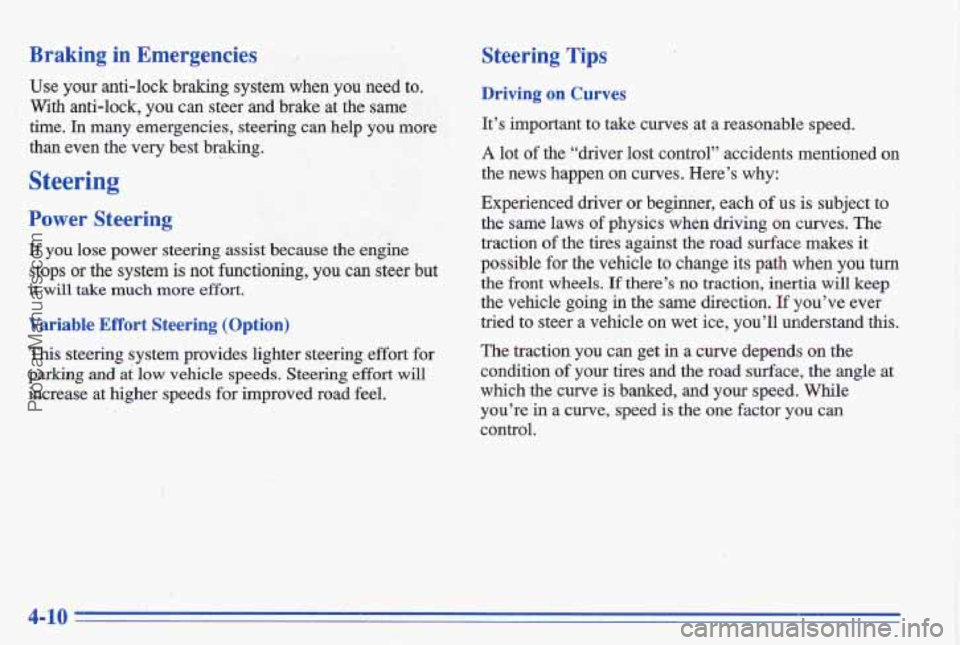Page 68 of 356

LOCK (B): Before you pur: the key into the ignition
switch, the switch is
in LOCK. It’s also the only position
in which you can remove the key. This locks your
steering wheel, ignition and transaxle
(on automatic
models).
OFF (C): This position unlocks the steering wheel,
ignition,
and transaxle (on automatic models), but does
not send electrical power to any accessories. Use this
position
if your vehicle must be pushed or towed, but
never
try to push-start your vehicle. A warning chime
will sound if you open the driver’s
door when the
ignition
is off and the key is in the ignition. 1
RUN (D): This position is where the key returns after
you
start your engine and release the switch. The switch
stays
in the RUN position when the engine is running.
But even when the engine
is not running, you can use
RUN to operate your electrical power accessories, and
to display
some instrument panel warning lights.
START (E): This position starts your engine. When the
engine
starts, release the key. The ignition switch will
return
to RUN for normal driving.
Note that even if the engine is not running, the positions
ACCESSORY and RUN are on positions that allow you
to operate your electrical accessories, such as the radio. On manual transaxle
vehicles, turning the key to
LOCK will lock the steering column and result in
a loss of ability to steer the vehicle. This could
cause
a collision. If you need to turn the engine
off while the vehicle is moving, turn the key only
to
OFF. Don’t press the key release button while
the vehicle is moving.
NOTICE:
If your key seems stuck in LOCK and you can’t
turn it,
be sure it is all the way in. If it is, then
turn the steering wheel
left and right while you
turn the key hard. But turn the key only with
your hand. Using a tool to force it could break
the key or the ignition switch. If none of this
works, then your vehicle needs service.
2-12
ProCarManuals.com
Page 86 of 356

Windows
On a vehicle with manual windows, use the window
crank located on the inside of each door to open and
close each window.
Power Windows (Option)
Switches on the driver’s door armrest control each of the
windows when the ignition is on.
In addition, each
passenger door has a switch for its own window. The driver’s window switch has
an auto-down feature.
This switch
is labeled AUTO. Tap the switch back, and
the driver’s window will open a
small amount. When the
switch is moved all the way back, the window will go
down all the way.
To stop the window while it is lowering, move the .
switch forward. To raise the window, move and hold the
switch forward.
On four-door models, the driver’s window controls also
include a lock-out switch.
Press REAR LOCK OUT to
stop front and rear passengers from using their window switches.
The driver can still control all of the windows
with the switch in the lock position. Press the other side
of the
REAR LOCK OUT button for normal window
operation.
--
Horn
Press the center of your steering wheel to sound the
horn.
2-30
ProCarManuals.com
Page 145 of 356

Steering Wheel Controls (Option)
.-
\u u/
If your vehicle has this feature, you can control certain
radio functions using the buttons on your steering wheel.
SEEK: Press the up arrow to tune to the next radio
station and the down
arrow to tune to the previous radio
station.
If a cassette tape or compact disc is playing, the
player will advance with the up arrow
and rewind with
the down arrow.
AM-FM: Press this button to choose AM, FM1 or
FM2. If a cassette tape or compact disc is playing, it will
stop and the radio will play.
PRESET Press this button to play a station you have
programmed on the radio preset buttons.
PLAY Press this button to play a cassette tape or
compact disc when the radio
is playing.
MUTE: Press this button to silence the system. Press it
again, or any other radio button, to turn on the sound.
VOL: Press the up arrow to increase the volume and the
down arrow to decrease volume.
Understanding Radio Reception
FM Stereo
FM stereo will give you the best sound. But FM signals
will reach only about
10 to 40 miles-( 16 to 65 km). Tall
buildings or hills can interfere with
FM signals, causing
the sound to come and
go.
AM
The range for most AM stations is greater than for FM,
especially at night. The longer range, however, can
cause stations to interfere with each other.
AM can pick
up noise from things like storms and power lines. Try
reducing the treble to reduce this noise
if you ever get it.
3-23,
ProCarManuals.com
Page 158 of 356

Braking in Emergencies
Use your anti-lock braking system when you need to.
With anti-lock, you can steer and brake at the same
time. Tn many emergencies, steerirzg’cm help you more
thin even the very best braking. -
Steering
Power Steering
If you lose power steering assist because the engine
stops or the system is not functioning,
you can steer but
it will take much more effort.
Variable Effort Steering (Option)
This steering system provides lighter steering effort for
parlcitlg ad at low vehicle speeds. Steering effurt will
increase at higher speeds for improved road feel.
Steering Tips
Driving on Curves
It’s important to take curves at a reasonable speed.
A lot of the “driver lost control” accidents mentioned on
the news happen on curves. Here’s why:
Experienced driver or beginner, each of us is subject to
the same laws
of physics when driving on curves. The
traction
of the tires against the road surface makes it
possible
for the vehicle to change its path when you turn
the front wheels.
If there’s no traction, inertia will keep
the vehicle
going in the same direction. If you’ve ever
tried
to steer a vehicle on wet ice, you’ll understand this.
The traction you can get
in a curve depends on the
condition
of your tires and the road surface, the angle at
which the curve is banked,
and your speed. While
you’re
in a curve, speed is the one factor you can
control.
4-10,
ProCarManuals.com
Page 230 of 356
2.4L (CODE T) Engine
When you open the hood, you’ll see:
Brake Fluid Reservoir
B. Engine Oil Fill Cap G. Windshield Washer Fluid Reservoir
C. Engine Oil Dipstick M. Hydraulic Clutch Fluid Reservoir (if so equipped)
D. Automatic Transaxle Dipstick (if equipped) I. Air Cleaner
E. Power Steering Fluid Reservoir J. Battery
6-8
ProCarManuals.com
Page 231 of 356
3.1L (CODE M) Engine
When you open the hood, ou’ll see:
A. Engine Coolant Surge Tank
B. Power Steering Fluid Reservoir
C. Engine Oil Fill Cap
D. Engine Oil Dipstick
E. Automatic Transaxle Fluid Dipstick
6-9
E Brake Fluid Reservoir
G. Windshield Washer Fluid Reservoir
H. Air Cleaner
I. Battery
ProCarManuals.com
Page 248 of 356
Surge Tank Pressure Cap
NOTICE: ~~ ~
Your pressure cap is an 15 psi l(105 kPa)
pressure-type cap and must be tightly installed to
prevent coolant loss and possible engine damage
from overheating,
When you replace your surge tank pressure cap, a GM
cap is recommended.
Thermostat
Engine coolant temperature is controlled by a thermostat
in the engine coolant system, The thermostat stops the
flow of coolant through the radiator until the coolant
reaches
a preset temperature.
When you replace your thermostat,
an AC@ thermostat
is recommended.
Power Steering Fluid
When to Check Power Steering Fluid
It is not necessary to regularly check power steering
fluid unless
you suspect there is a leak in the system or
you hear an unusual noise. A fluid loss in this system
could indicate a problem. Have the system inspected
and
repaired.
6-26
ProCarManuals.com
Page 278 of 356
Fuse
INT LPS
PWR
ST
RDO IGN
HTR-A/C
CRUISE
TAIL LPS
a Fuse Useage
PWR WDO Power Window (Circuit Breaker)
TURN Turn Signal Lamps
Useage
Alarm Module (Illuminated Entry,
Warning Chimes, Overhead
Lamps., MapJReading Lamps,
Glove Box Lamp, Trunk Lamp,
Radio, Power Mirrors), Anti-Lock
Brakes, Variable
Effort Steering,
Remote Keyless
Entry
Power Seat ?,,,. :. . . .- . - . .. .. Radi&-<-'&'.: ?.>I' ?;~-,~:-~~~,(l ,;,* , ' _. . . I' . &-:.*& . : ' . . I 8.. .~ . . .I d&
Heater/Air Conditioning Blower,
Daytime Running Lamps, Automatic Light Control
Cruise Control
Parking Lamps, Taillamps,
Sidemarker Lamps, License
Lamps, Instrument Panel Lights,
Headlamp
Warning Alarm
Cigarette Lighter
6-56
ProCarManuals.com